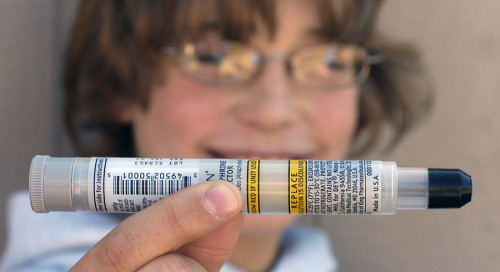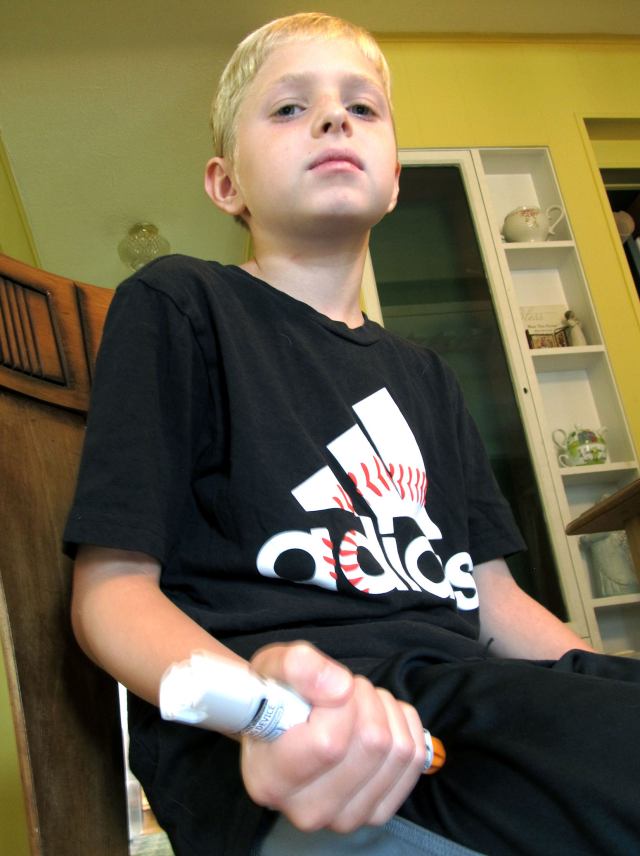School EpiPens and Anaphylaxis
Life threatening events happen to our children more often than we would like; and, merely because it’s where they spend much of their time, such events occur at school a lot. Today, we’ll talk about the allergic reactions known as anaphylaxis and their treatment at school.
10 year old with epipen for use at school
Public schools, charter schools, private schools – none of them are exempt but level of preparation for them may surprise. Eight percent of children have bonafide food allergies and 25% of their first reactions occur at school, any school.
Food Allergies, Schools and Epipens
The first thing re REALLY MUST talk about is what the true definition of “food allergy” is because, next to the term “flu”, there is a whole lot of very sloppy usage of the term by many uninformed parents which makes life difficult for those with TRUE allergies.
Lest you get the impression that the term “uninformed” is a bit too harsh, my experience shows me that most of the reason the term is used incorrectly is because the person has never ever even seen a person with true allergies. Once you’ve seen a bonafide allergic reaction to food there is really never any question about it, let me explain.
Food PREFERENCES
As a practicing physician for many years preference is what the MAJORITY of uninformed parents are talking about when they say “my kid has food allergies.”
The fact that a baby pulls a face, or spits food out, or gags themselves when they taste it or stubbornly refuse to eat any one kind of food does NOT mean they have a food allergy! All that I described is a child’s preference against a particular food taste, texture or color and these are almost always learned habits taught to them by (well, you know who).
Tantrums and other such reactions when given foods that are not liked can be “parented” away; but, usually do not resolve without some effort (a topic for another article).
Food INTOLERANCE
If a baby is given chocolate and gets hyper – that is NOT an allergy! If a child is given beans or broccoli etc. and gets gas – that is NOT allergy! If an infant is given breast milk and has runny stools – that is NOT allergy.
Those, and may others, are food INTOLERANCES, meaning a not-unexpected, sometimes idiosyncratic, result of eating the food; but, again, NOT an allergy.
Intolerances can NOT be trained away; but, many times change on their own with age or growth.
Food ALLERGIES
Real, true, bonafide food allergy is not even in the same ballpark as food preference. And, it’s different from food intolerance as well; because: food allergy is an additional response of the body where it secretes hormones and substances through the immune system (immune mediated) which can cause severe life-threatening reactions after the food is ingested. Sometimes immediate, sometimes delayed.
This dangerous reaction is called anaphylaxis and consists of such symptoms as: trouble breathing, wheezing, throat closure, hives, low blood pressure, vascular collapse and death.
Currently, there is no treatment or cure for the food allergy. Treatment and prevention of the anaphylaxis it causes is only by the timely administration of an EAI – epinephrine auto-injector, which is a child’s first and primary line of defense.
Food Allergies and Schools and Epipens
Reports of loss of lives at school due to anaphylactic shock is well documented. About 25% of children experience their very first allergic reaction in school; so school districts need to be prepared for such an emergency. Of children with a known (bonafide) food allergy, only a fourth have access to their Epipen at school!
To top that off, 30% of school nurses report they have used one student’s prescribed medication to rescue another student in distress! In this day and age, and knowing what we know, a shameful statistic.
The problem(s)? The demise of the school nurse position in many school districts [see previous article] for one. Uninformed or misinformed school officials and public for another.
Are you beginning to see why parents who describe their child’s whims and burps as “food allergy” make life difficult for those with REAL allergies. Sometimes MORE than just difficult, downright deadly.
The solution? Undesignated epinephrine (not specific to any one child) easily accessible and immediately available in all schools with teachers, staff and administrators trained in first aid which includes identification of anaphylaxis and epipen use. Simple!
So why in 2015 are there still schools without even a policy for such activities? The Chicago Public Schools was the first large, urban US school district to begin stocking undesignated EAIs for the treatment of acute allergic reactions in 2012-13; but, that was only in response to federal and their state’s legislation.
Let’s look at the results of their first years worth of experience. For all of the rest of us, the story should be self-explanatory.
First Year Experience With Epipens
A physician affiliated with the school system wrote a prescription to obtain EAIs for the first aid kits of each school and “standing orders” for when and how to use them – first step.
The school then obtained the devices for each school and, prior to the 2012-2013 academic year, saw to it that key personnel were trained on how to spot allergic reactions, identify which were leading to anaphylaxis and how to use Epipens as well as other emergency procedures.
Once ready, they awaited their first child to need first aid – and it wasn’t long. In all, 38 doses were issued that year primarily to students (92.2%). Sixty-three percent of them were in the elementary schools and 37% in the high-schools.
Most of the time, but not all, (76.3%) the shots were administered by school nurses. Emergency 911 was called in 81.6% of the incidents.
The number of “suprise” anaphylaxis episodes was 55% – which was a surprise to them too because previous literature had estimated first-time school incidents to be half that (20-25%). This is where the timely use of a readily available EAI is critical.
In case you’re wondering, the majority of EAI uses were food-related (55.3%), primarily peanuts (18.4%) and fin fish (13.2%). Other causes included insect venom (5.3%), animals (2.6%), and grass (2.6%). However, more than one third of cases (34.2%) lacked an identifiable trigger.
The one thing the district didn’t seem prepared for (perhaps because they had no clue of the significance of the problem) was tracking the data! When the true incidence of the problem was finally realized, they needed to switch from paper record-keeping to a computerized database – which gave inconsistencies in case details, not always for the better.
In the case of Chicago’s experience they discovered that a good fourth (26.3%) of the EAIs were administered to students on Chicago’s far south side, an unknown fact that was discovered to be associated with a substantially lower rate of physician-documented food allergy diagnoses (?) compared with the North-Northwest side (8% vs 47%)!
“This underscores the need for access to district-issued EAIs citywide, as children on the Far South Side may not have access to [prior] food-allergy diagnosis and could experience their first allergic reaction at school,” they wrote in their summary report.
Even if you’re not the type that likes to worry about your child at school, perhaps this is a question that you should bring up at your next PTA (parent-teacher association) meeting. Does your school district have a policy on the use of EAIs and anaphylaxis treatment? If so, what is it? Does it include school nurses and Undesignated epinephrine as well as parent-supplied EAIs?
[Am J Prev Med. Published online October 22, 2014]




